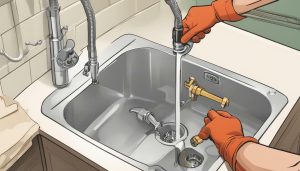Tools and Materials Needed for Kitchen Faucet Installation
Before you embark on your kitchen faucet installation project, it’s important to gather all the necessary tools and materials to ensure that everything goes smoothly. Here’s a list of items you’ll need to bring together before getting started:
- Adjustable wrench: For securely tightening and loosening pipe fittings
- Basin wrench: For tightening hard-to-reach nuts under the sink
- Pliers: For tightening and loosening nuts and bolts
- Screwdriver: For removing screws that hold the previous faucet in place and tightening screws of the new one
- Plumber’s putty or silicone caulk: For sealing the area around the base of the faucet
- Teflon tape: For wrapping the threads of the supply pipes that connect to the faucet, to prevent leaks
- New kitchen faucet: Ensure you have all components that came with the faucet, such as handles, sprayer, and other attachments
Having these tools and materials readily available before starting the installation process will ensure that you can complete the project without having to make multiple trips to the hardware store, which can be time-consuming and frustrating.
Shutting Off the Water Supply for Kitchen Faucet Installation
Before you begin removing your old faucet and installing the new one, make sure to turn off the water supply to prevent any mishaps or water damage.
You can usually find the shut-off valve located under the sink or near the main water supply for your home. Turn the valve clockwise until it’s completely closed to shut off the water supply to the faucet.
If you’re having trouble locating the shut-off valve, or it’s not working correctly, consider turning off the main water supply for your home. It’s crucial to ensure that the water supply is completely turned off before proceeding with the faucet installation.
Remember to test the water supply by turning on the faucet after shutting off the valve. If no water comes out, you’ve successfully turned off the water supply.
Steps to Remove the Old Kitchen Faucet
Removing the old kitchen faucet is essential to ensure a smooth installation process for the new one. Follow these steps carefully to avoid damaging your sink or countertop.
Step 1: Turn Off Water Supply
Before you begin removing the old faucet, you must turn off the water supply. Look for the shut-off valves under the sink and turn them clockwise until they’re completely closed. If there are no shut-off valves, turn off the main water supply to your home.
Step 2: Disconnect Water Lines
Use adjustable pliers to remove the water lines connected to the faucet. Place a bucket or towel under the connections to catch any water drips. Use a basin wrench to loosen and remove the mounting nuts that hold the faucet in place.
If the mounting nuts are hard to remove, apply penetrating oil and let it sit for a few minutes before trying again.
Step 3: Remove Old Faucet
Once the water lines and mounting nuts are disconnected, lift the old faucet out of the sink. Clean the area around the mounting holes with a cloth or scrub brush to remove any debris.
“Be sure to support the sink or countertop underneath the faucet while removing it to prevent any damage.”
Now that the old kitchen faucet is removed, you’re ready to prepare the sink for the new faucet installation.
Preparing the Sink for New Kitchen Faucet Installation
Before beginning the installation of your new kitchen faucet, it’s important to properly prepare the sink to ensure a suitable surface for the installation.
The first step in preparing the sink is to thoroughly clean the area around the mounting holes. Use a mild cleaner and a soft cloth to remove any debris or residue that may be present. Once the area is clean and dry, you can proceed to the next step.
Checking the Mounting Holes
After cleaning the area around the mounting holes, inspect them thoroughly. It’s essential to ensure that the holes are the correct size for your new faucet, and that they are not damaged in any way. Check the manufacturer’s instructions for the size and shape of the mounting holes required for your particular faucet model. If the holes are the wrong size or shape, or if they are damaged, you may need to repair or replace your sink before proceeding with the installation.
Applying Plumber’s Putty or Silicone Caulk
Applying plumber’s putty or silicone caulk around the base of the faucet can help to create a watertight seal and prevent water from leaking into the area beneath the sink. To apply, roll a small amount of putty or caulk into a thin rope and place it around the base of the faucet. Then, carefully position the faucet over the mounting holes and press it firmly into place. Wipe away any excess putty or caulk with a damp cloth.
Note: Always refer to the manufacturer’s instructions for specific recommendations on the use of plumber’s putty or silicone caulk.
Preparing the Mounting Hardware
Before attaching the mounting hardware to the sink, ensure that all parts are present and in good condition. If any parts are missing or damaged, contact the manufacturer for replacements before proceeding with the installation.
Once all the hardware is present and in good condition, attach the mounting brackets to the underside of the sink. Use the manufacturer’s instructions to guide you through this process, as it may vary depending on the faucet model.
With the mounting brackets in place, you can now proceed to install the faucet.
Step-by-Step Guide for Installing a New Kitchen Faucet
Now that you have gathered all the necessary tools and materials, turned off the water supply, removed your old faucet, and prepared the sink, it’s finally time to install your new kitchen faucet. Follow these step-by-step instructions carefully for a successful installation:
Step 1: Attach the Mounting Hardware
Using the mounting hardware that came with your new faucet, attach the base plate and any other necessary components to the sink.
Step 2: Connect the Water Supply Lines
Attach the water supply lines to the corresponding valves under the sink. Use plumber’s tape to ensure a tight seal. Tighten the connections with an adjustable wrench.
Step 3: Position and Secure the Faucet
Position the faucet onto the base plate and align it with the sinkholes. Tighten the mounting hardware to secure the faucet. Be sure not to overtighten and damage the sink.
Step 4: Attach the Spray Hose and Other Components
If your faucet includes a spray hose or other additional components, attach them according to the manufacturer’s instructions.
Step 5: Turn On the Water Supply
Turn on the water supply valves and check for any leaks around the connections. Tighten any loose connections as necessary. Allow the water to run for a few minutes to flush out any debris before using the faucet.
Step 6: Test the Functionality of the Faucet
Test the functionality of the faucet, including the hot and cold water handles and any additional components, to ensure everything is working correctly. Make any necessary adjustments, such as tightening loose handles or adjusting the water flow, until the faucet operates smoothly.
Congratulations! You have successfully installed your new kitchen faucet. Now, move on to Section 6 to test for leaks and ensure proper functionality.
Testing for Leaks and Ensuring Proper Functionality
Now that the new kitchen faucet has been installed, it’s important to check for leaks and ensure it’s functioning correctly. Follow these simple steps to complete this process:
- Turn on the water supply to the faucet.
- Allow the water to run for a few minutes. Check for any leaks around the connections and base of the faucet.
- If there is any leakage, tighten the connections further using pliers or an adjustable wrench. Do not overtighten as this may cause damage to the faucet or pipes.
- If there are no leaks, turn off the water supply to the faucet.
- Move the faucet handle back and forth to test the hot and cold water supply.
- Check the sprayer and test the water flow from the faucet. If the water pressure is low, remove the aerator and clean it.
- If the sprayer is not functioning correctly, check and remove any debris or mineral buildup in the sprayer head.
- If everything is functioning correctly, the installation process is complete.
Note: It’s important to test the faucet for leaks and proper functionality before using it regularly. This will avoid any potential damage to the sink or water supply system.
“Regularly checking and cleaning the aerator and sprayer head will ensure proper water flow and pressure.”
Finalizing the Kitchen Faucet Installation and Cleaning Up
Congratulations! You’ve successfully installed your new kitchen faucet and improved the functionality of your kitchen. Now that the hard part is over, it’s time to add the finishing touches and make sure everything is clean and tidy.
The first step is to turn on the water supply and test your new faucet for any leaks or malfunctions. Run both hot and cold water for a few minutes and check the connections for any signs of leakage.
Once you’ve confirmed that everything is functioning properly, it’s time to clean up any mess left from the installation process. Wipe down the sink and surrounding area with a damp cloth, and dispose of any leftover packaging or debris.
If your new faucet came with a decorative baseplate, now is the time to install it. Simply slide it over the base of the faucet and tighten the mounting screws until it’s secure.
Finally, take a step back and admire your handiwork. Enjoy the upgraded look and functionality of your kitchen faucet, and take satisfaction in knowing that you were able to install it yourself.
Troubleshooting Tips and Common Issues During Kitchen Faucet Installation
Installing a kitchen faucet can be a straightforward process, but sometimes things don’t go as planned. Here are some common issues that may arise during the installation process and troubleshooting tips to help you overcome them.
Leaky Connections
A common issue that people may encounter is leaky connections. This is typically caused by loose connections or not using enough plumbing tape. Make sure to use plumbing tape on all threaded connections, and tighten them securely with pliers. If you notice a leak, try tightening the connections first. If that doesn’t work, you may need to replace the plumbing tape or the faulty component.
Low Water Pressure
Low water pressure is another common issue that you may encounter after installing a new kitchen faucet. This can be caused by a variety of factors, including a clogged aerator or valves that are not fully opened. Check to make sure all valves are fully opened and that there are no clogs in the aerator. If the issue persists, you may need to clean or replace the aerator.
Difficulty Removing the Old Faucet
Removing an old faucet can be a challenging task, especially if it’s been in place for a long time. If the old faucet is stuck, try using a penetrating oil to loosen it before attempting to remove it. You may also need to use a wrench or pliers to help loosen any stubborn connections. If all else fails, consider calling a professional plumber for assistance.
Pro Tip: It’s always a good idea to have a backup plan in case something goes wrong during the installation process. Keep a bucket and towels handy in case of any leaks, and make sure to turn off the water supply before removing the old faucet.
Conclusion
Congratulations on successfully installing your new kitchen faucet! By following our step-by-step guide and tips, you’ve completed a DIY project that enhances the functionality and aesthetic of your kitchen. Your new faucet will not only make your life easier, but it will also add a new element of style to your space.
Remember to test for leaks and ensure that your new kitchen faucet is functioning correctly before considering the installation process complete. If you encounter any issues during the installation, refer to our troubleshooting tips and common problems section for assistance.
Thank you for choosing our guide to assist you in your kitchen faucet installation. We hope that this information has been helpful and that you feel empowered to tackle future DIY projects. Enjoy your new faucet and the satisfaction of a job well done!
FAQ
Q: What tools and materials do I need for kitchen faucet installation?
A: To successfully install your new kitchen faucet, you’ll need the following tools and materials: adjustable wrench, basin wrench, plumber’s tape, screwdriver, bucket, towels, new faucet and supply lines.
Q: How do I shut off the water supply for kitchen faucet installation?
A: Before removing your old faucet and installing the new one, you’ll need to turn off the water supply. To do this, locate the shut-off valves underneath your kitchen sink and turn them clockwise until they are fully closed.
Q: What are the steps to remove the old kitchen faucet?
A: To remove the old kitchen faucet, follow these steps: 1. Turn off the water supply. 2. Disconnect the supply lines. 3. Remove the mounting nuts. 4. Lift the old faucet off the sink.
Q: How do I prepare the sink for new kitchen faucet installation?
A: Before installing the new kitchen faucet, make sure to clean the sink thoroughly and remove any debris. Apply a bead of plumber’s putty around the base of the new faucet, ensuring a watertight seal.
Q: What is the step-by-step guide for installing a new kitchen faucet?
A: Follow these steps to install your new kitchen faucet: 1. Position the new faucet on the sink. 2. Attach the mounting hardware and secure it tightly. 3. Connect the supply lines to the faucet. 4. Turn on the water supply and check for leaks. 5. Test the functionality of the faucet.
Q: How do I test for leaks and ensure proper functionality?
A: After installing the new kitchen faucet, turn on the water supply and check for any leaks around the connections. Test both hot and cold water. If any leaks or issues are found, make necessary adjustments and retest.
Q: How do I finalize the kitchen faucet installation and clean up?
A: Once the installation is complete and the faucet is functioning properly, clean up any mess created during the process. Wipe down the sink, remove any debris, and ensure the area is tidy.
Q: What are some troubleshooting tips and common issues during kitchen faucet installation?
A: If you encounter issues during the kitchen faucet installation, try these troubleshooting tips: 1. Check for proper alignment and tightening of connections. 2. Use plumber’s tape to create a secure seal. 3. Ensure proper positioning of gaskets or washers. If problems persist, consult a professional plumber.
Conclusion
Congratulations! You have successfully installed your new kitchen faucet. By following our step-by-step guide and tips, you’ve completed a DIY project that enhances the functionality and aesthetic of your kitchen. Enjoy your new faucet and the satisfaction of a job well done.

It’s me, Amber Hayden, the heart and soul behind SagarmathaOnlineMedia.com. From a young age, I’ve been head over heels for everything home-related, from interior decor to gardening. I’m the type who can’t resist a well-crafted piece of furniture, and I firmly believe that a home isn’t complete without a pet or two. But it’s not just about creating pretty spaces for me. I’m all about making homes that tell a story reflecting the people living there. SagarmathaOnlineMedia.com is my way of sharing this passion with you. Whether you’re looking for tips to jazz up your living room, advice on pet care, or ideas to make your garden bloom, I’m here to help. So, let’s embark on this journey together and make your house a home!



